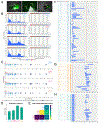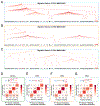Clonal Lineage Tracing with Somatic Delivery of Recordable Barcodes Reveals Migration Histories of Metastatic Prostate Cancer
- PMID: 38969342
- PMCID: PMC11984259
- DOI: 10.1158/2159-8290.CD-23-1332
Clonal Lineage Tracing with Somatic Delivery of Recordable Barcodes Reveals Migration Histories of Metastatic Prostate Cancer
Abstract
The patterns by which primary tumors spread to metastatic sites remain poorly understood. Here, we define patterns of metastatic seeding in prostate cancer using a novel injection-based mouse model-EvoCaP (Evolution in Cancer of the Prostate), featuring aggressive metastatic cancer to bone, liver, lungs, and lymph nodes. To define migration histories between primary and metastatic sites, we used our EvoTraceR pipeline to track distinct tumor clones containing recordable barcodes. We detected widespread intratumoral heterogeneity from the primary tumor in metastatic seeding, with few clonal populations instigating most migration. Metastasis-to-metastasis seeding was uncommon, as most cells remained confined within the tissue. Migration patterns in our model were congruent with human prostate cancer seeding topologies. Our findings support the view of metastatic prostate cancer as a systemic disease driven by waves of aggressive clones expanding their niche, infrequently overcoming constraints that otherwise keep them confined in the primary or metastatic site. Significance: Defining the kinetics of prostate cancer metastasis is critical for developing novel therapeutic strategies. This study uses CRISPR/Cas9-based barcoding technology to accurately define tumor clonal patterns and routes of migration in a novel somatically engineered mouse model (EvoCaP) that recapitulates human prostate cancer using an in-house developed analytical pipeline (EvoTraceR).
©2024 American Association for Cancer Research.
Conflict of interest statement
The authors declare no potential conflicts of interest.
Figures






References
-
- Disibio G, French SW. Metastatic patterns of cancers: results from a large autopsy study. Arch Pathol Lab Med. 2008;132(6):931–9. - PubMed
MeSH terms
Grants and funding
- T32 CA203702/CA/NCI NIH HHS/United States
- R35-GM127070/National Institutes of Health (NIH)
- R35 GM127070/GM/NIGMS NIH HHS/United States
- Research Scholar Grant/American Cancer Society (ACS)
- 22790/Cancer Research UK (CRUK)
- T32 GM141949/GM/NIGMS NIH HHS/United States
- T32CA203702/National Cancer Institute (NCI)
- P30 CA045508/CA/NCI NIH HHS/United States
- 1T32GM141949/National Institutes of Health (NIH)
- W81XWH-22-1-0068/Department of Defense Education Activity (DoDEA)
- 22790/Fondazione AIRC per la ricerca sul cancro ETS (AIRC)
- 5T32GM141949/National Institutes of Health (NIH)
- R01-CA272466/National Cancer Institute (NCI)
- R01 CA272466/CA/NCI NIH HHS/United States
- Centennial Scholarship/Starr Foundation (TSF)
LinkOut - more resources
Full Text Sources
Medical
Molecular Biology Databases
Research Materials

